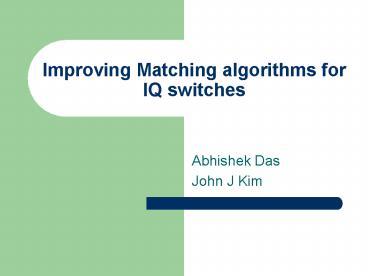Improving Matching algorithms for IQ switches - PowerPoint PPT Presentation
Title:
Improving Matching algorithms for IQ switches
Description:
With speedup 2, OQ switch can be emulated [Shang-Tse ... Holi-PIM (or HIM) ... a new practical iterative matching algorithm: Holi-PIM under unform traffic ... – PowerPoint PPT presentation
Number of Views:37
Avg rating:3.0/5.0
Title: Improving Matching algorithms for IQ switches
1
Improving Matching algorithms for IQ switches
- Abhishek Das
- John J Kim
2
Motivation
- Results known
- With speedup 2, OQ switch can be emulated
Shang-Tse Chuang et al - Maximum Weight Matching (MWM) provides 100
throughput McKeown et al - With speedup 2, any maximal matching can achieve
100 throughput Dai and Prabhakar - What about maximal matching algorithms with
weights within a factor of k of MWM
(k-approximation)? - Is speedup s lt 2 sufficient to guarantee
stability?
3
Fluid model equations for switch
- Queue-lengths represented by ?ij(t)
- ?ij(t) ?ij(0) Aij(t) - Dij(t) ? 0
- ?ij ?(t) ?ij(t) - Dij ?(t)
- Dij?(t) ? ijm 1?ij(t)gt0
- for any admissible load matrix ?, ??, ?(t)? ? W
(using Birkhoff-von Neumann decomposition), where
W is the weight of Maximum Weight Matching
4
K-approximation to MWM
- Lyapunov function L(t) ??(t), ?(t)?
- L?(t) 2???(t), ?(t)?
- 2??(t), ?(t)? - ?D?(t), ?(t)?
- ? 2W - ?D?(t), ?(t)?
- Using speedup s, ?D?(t), ?(t)? ?s.? ijm , ?(t)?
- L?(t) ? 2W - ?s.? ijm , ?(t)?
- 2W - s.w (w is weight of the
matching) - ? 0 if W ? s.w
- Now for a k-approximation matching algorithm, k.w
? W - If k ? s, we satisfy W ? k.w ? s.w and achieve
100 throughput.
5
K-approximation to MWM (contd.)
- Greedy iLQF is 2-approximation
- requires speedup s gt 2 (but so does any maximal
matching) - Any other k-approximation to weighted matching?
- Weighted matching algorithms use min-cost
max-flow algorithms - Futile attempts at coming up with other Lyapunov
functions - Cij(n) Xi(n) Yj(n) - ?ij(n)where Xi(n) ?j?
?ij?(n) and Yj(n) ?i? ?i?j(n)
6
Why look at VOQ sizes?
- Disappointed souls looking at the bigger
picture!! - Weights are bad for hardware complexity
- Requires multi-bit integer comparators
- LPF is already stable without speedup
- LPF vs LQF(MWM)
- Ratio of matching weights vary from 1 (70 load)
to 20 (90 load)
7
Matching size with speedup s
- Maximum size matching is not stable
- Requires speedup?
- L(t) ??(t), 1?
- L?(t) ???(t), 1?
- ??(t), 1? - ?D?(t), 1?
- ??(t), 1? ? N because ?i?ij ? 1 and ?j?ij ? 1
- ?D?(t), 1? ? ??ijm , 1? since D ij?(t) ?ijm
1?ij(t)gt0 - L?(t) ? N - ?i?Mi?
- speedup s s matchings
- M is the size of the matching
- ? 0 if ?i?Mi? ? N, thus achieving 100
throughput. - Note that its total load (??(t), 1?) and not N
8
K-approximation vs Heuristics
- Many approximate matching algorithms known
(linear and poly-logarithmic) - Approximate matching algorithms compare to the
maximum size matching (not to the load) - Heuristics to improve the matching size of
practical iterative matching algorithms - speedup
9
Holi-PIM (or HIM)
- Attempt to improve upon PIM by generating bigger
size matching in each iteration - Observation poor matching occurs in PIM when
inputs receive multiple grants - Increase the size of matching by considering the
number of requests from each input - equivalent to considering the number of HOL
packets or the fanout from each input - Similar to lonely output allocator
(Interconnection Networks DallyTowles)
10
HIM implementation
- Requires log(N) control bits from each input
- Weights are assigned based on the fanout of each
input - How to break ties
- Randomly
- Round-robin manner
- Weighted probability vs strict weights
11
HIM1 vs PIM1 Matching Size
12
HIM1 vs PIM1 Latency
13
Problems with HIM
- HIM performs better than PIM but still does not
give 100 throughput - Fairness issue HIM is not a fair algorithm as it
will favor the shorter queues - iSLIP1 is known to give 100 throughput on
uniform traffic and has simple hardware
complexity - Can iSLIP take advantage of the HIM weights?
14
iSLIPHIM
- Add the HIM weights to iSLIP
- The weight of each edge of the request is
determined by combining the iSLIP weights
(priority pointers) and the HIM weights - At intermediate loads, HIM weight should improve
the performance - At high load, the HIM weights should be identical
and iSLIP should dominate
15
iSLIPHIM Size Matching
16
iSLIPHIM Latency
17
Non-uniform Traffic
- iSLIP is known to behave poorly on non-uniform
traffic pattern - HIM does not significantly improve on non-uniform
as it is an attempt of maximum size matching, not
maximum weight
18
Non-uniform Traffic Results
19
Future Improvements
- Incorporate weights into HIM
- Have predetermined threshold on the size of the
VOQ and use them as priorities
20
Conclusions
- Showed required stability conditions for matching
algorithms (with and without weight) - Introduced and studied a new practical iterative
matching algorithm Holi-PIM under unform traffic































